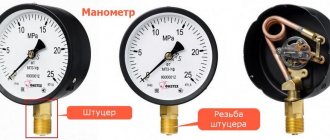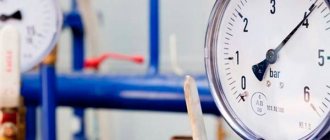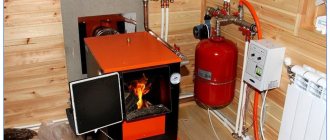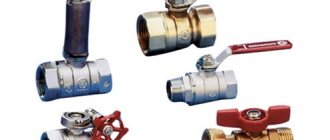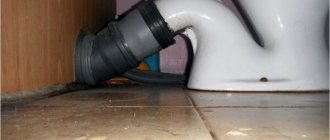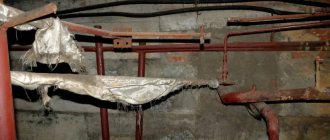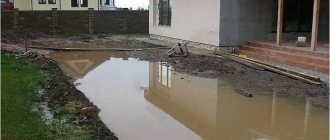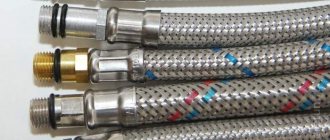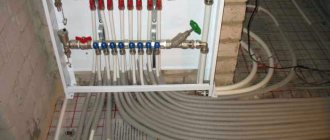How to design and make a water supply system that would meet all our requirements
Dmitry Belkin
Author: Dmitry Belkin
It is difficult to imagine a modern home without running water. Moreover, time passes, progress does not stand still, and water supply systems are being improved. The latest plumbing systems are appearing, which not only allow you to get water “with bubbles,” which is very pleasant, but also significantly save water. And saving water in a modern cottage is a very important thing. By saving water, we save our money on repairing pumping equipment, on electricity, on cleaning the septic tank and, most importantly, by saving water, we save our planet, and failure to comply with environmental standards is, according to the most modern moral, ethical and religious standards, a mortal sin.
In order for the water supply in our house to fully meet all modern requirements, we need to achieve the following characteristics from it. The water should flow smoothly, that is, there should be no strong pressure drops. It should not make noise in the pipes, and should not contain air or foreign inclusions that could break our modern ceramic valves and other devices. The water must be in the pipes under a certain pressure. The minimum of this pressure is 1.5 atmospheres. This is the minimum that allows modern washing machines and dishwashers to operate. However, since this is already the second version of the article, we can say that the specified minimum is conditional. At least for a large number of readers who are ready to sacrifice their comfort, washing machines operate at lower pressure, about which I received quite a large number of reproachful letters. The issue with dishwashers remains open, since to my memory none of the readers with low-pressure water supply systems have used dishwashers.
Do not forget about the second main technical characteristic of the water supply system (the first is pressure). This is water consumption. We need to be sure that we can take a shower while washing dishes in the kitchen, and if there are 2 bathrooms in the house, then it should not turn out that you can only use one, and there is not enough water for the second. Fortunately, modern pumping stations allow you to design a water supply taking into account both important characteristics, that is, water pressure and flow.
Since ancient times, water towers have been used to create water supply. I've always liked them. They look beautiful and powerful. They can be seen from afar. I believe that everyone should like them, especially ladies, since they are phallic symbols, and the phallus is the personification of light, strength and masculinity. But I digress... The meaning and purpose of a water tower is not at all to arouse all the best feelings in people, although this is also important, but to create sufficient pressure in the water supply. Pressure is measured in atmospheres. If we raise water to a height of 10 meters and allow it to flow down, then at ground level the weight of the water column will create a pressure equal to one atmosphere. The five-story house has a height of 15-16 meters from the ground. Thus, a water tower the height of a five-story building will create a pressure of 1.5 atmospheres at ground level. If you connect the tower to a five-story building, then we can say that the residents of the first floor will have the same agreed pressure of 1.5 atmospheres. Residents on the second floor will have lower pressure. If the height of the water column is 15 meters, the level of the valve on the second floor is, say, 3.5 meters from the ground, then the pressure in it will be 15-3.5 = 11.5 meters of water column, or 1.15 atmospheres. Residents of the fifth floor will have no pressure in the water supply at all! They can be congratulated on this. Let them go wash with friends on the first and second floors.
Obviously, to obtain a pressure of 4 atmospheres, we need to build a water tower 40 meters high, which is approximately the height of a house of 13 floors, and it does not matter at all what tank is on top of our super tall tower. You can drag even a 60-ton railway tank there, and the pressure will remain exactly 4 atmospheres. Needless to say, the task of building a 40-meter-high water tower is very difficult and costly. It is absolutely unprofitable to build such a tower and that is why they are not built. Well, thank God, although the phallus is as tall as a 13-story building... it's impressive.
The story about water towers is banal and therefore useless. The information is obvious and known to everyone. I hope it at least amused the readers. It is clear that a modern water pump is much more profitable and reliable than a water tower. But we’ll talk about pumps in the next articles of the series.
What should the pressure be in practice?
The fact that the minimum pressure may be 0.3 atm does not mean that this indicator is sufficient for full use of cold water. No household appliance will simply function at such a low pressure, so even if in theory you are absolutely within the norm, in practice things may not be so attractive.
Any standard apartment has a lot of household equipment that works with water: from a washing machine to a jacuzzi. These devices, depending on the power, put forward their own requirements for the incoming water pressure:
- dishwashing and washing equipment – 2 atm;
- heating boiler - 2.5-3 atm;
- shower with hydromassage – 3.5-4 atm;
- jacuzzi – 4 atm.
Practice shows that the optimal cold water pressure for an apartment is 4-5 atm.
Water consumption
Let's now look at water consumption. It is measured in liters per hour. In order to obtain liters per minute from this characteristic, you need to divide the number by 60. Example. 6,000 liters per hour is 100 liters per minute or 60 times less. Water flow should depend on pressure. The higher the pressure, the greater the speed of water in the pipes and the more water passes through a section of pipe per unit time. That is, more pours out from the other side. However, it's not that simple. The speed depends on the cross-section of the pipe and the higher the speed and the smaller the cross-section, the greater the resistance the water has when moving in the pipes. The speed, therefore, cannot increase indefinitely. Let's assume that we made a tiny hole in our pipe. We have the right to expect that water will flow out through this tiny hole at escape velocity, but this does not happen. The water speed, of course, increases, but not as much as we expected. Water resistance affects. Thus, the characteristics of the pressure and water flow developed by the pump are closely related to the design of the pump, the power of the pump motor, the cross-section of the inlet and outlet pipes, the material from which all parts of the pump and pipe are made, and so on. I say all this to mean that the characteristics of the pump written on its nameplate are generally approximate. They are unlikely to be larger, but reducing them is very easy. The relationship between pressure and water flow is not proportional. There are many factors that influence these characteristics. In the case of our submersible pump, the deeper it is immersed in the well, the less water flow on the surface. A graph that relates these values is usually given in the pump instructions.
Tips on how to determine the pressure in a water supply
The pressure in a water supply can be measured using an instrument called a water pressure gauge. There is a consumer version for home use with an adapter for connecting to equipment, for example, to a kitchen faucet.
There is a method for measuring pressure without using a pressure gauge. To do this, you will need a 3-liter jar and a stopwatch (or a watch with a second hand). It is necessary to open the tap at full power, substitute the can and note the time. After filling, you need to note the time it took to fill the jar. This will become a key indicator for determining pressure. The correspondence between the filling time of the jar and the pressure in the water supply was established experimentally and by calculation.
Let's look at this ratio in more detail in the table:
| Pressure in the water supply network (atm.) | Can filling time (seconds) |
| 0,10 | 14 |
| 0,14 | 13 |
| 0,19 | 10 |
| 0,24 | 9,5 |
| 0,34 | 8 |
These indicators are very approximate, and therefore can only become the basis for calling representatives of the management company to carry out official measurements using special equipment.
Construction of a household pumping station
To install a water supply system in a private house, you can create something like a small water tower at home, namely, place a tank in the attic. Calculate for yourself how much pressure you will get. For an ordinary home, this will be a little more than half the atmosphere, and even then at best. And this pressure will not increase if a larger capacity tank is used.
Obviously, it is impossible to get normal plumbing this way. You don’t have to worry and use the so-called pumping station, which consists of a water pump, a pressure switch and a membrane tank. The pumping station is different in that it turns the pump on and off automatically. How do you know when it’s time to turn on the water? Well, for example, use a pressure switch that turns on the pump when the pressure drops below a certain value, and turns it off when the pressure increases to another, but quite certain value. However, the pump turns on abruptly, resulting in a so-called water hammer, which can greatly damage our entire water supply system, including plumbing, pipes and the pump itself. To prevent shock, a membrane tank, or aqua accumulator, was invented.
That's what he is.
I used numbers to indicate the following:
- Tank body. Most often it is blue (cold water), but it can also be red, not necessarily for hot water.
- Inner tank made of food grade rubber
- Nipple. Just like a car tire
- Fitting for connection to water supply. depends on the tank capacity.
- Air space. Air under pressure
- The water that is inside the rubber tank
- Water outlet to consumers
- Water inlet from pump
The air is between the metal walls of the tank and the membrane. In the absence of water, obviously, the membrane is crushed and pressed against the flange in which the water inlet pipe is located. Water enters the tank under pressure. At the same time, the membrane expands and takes up space inside the tank. The air, which is already under pressure, resists the expansion of the water tank. At some point, the pressure of water in the membrane and air between the membrane and the tank is balanced and the flow of water into the tank stops. Theoretically, the water pressure in the water supply should reach the required value and the pump motor should turn off a little before the moment the air and water pressures balance.
To smooth out hydraulic shocks, we need a very small tank and it is completely unnecessary for it to be filled at all. However, in practice, owners prefer to use tanks of significant capacity. The tank capacity can be 50 or 100 liters and so on up to half a ton. The fact is that in this case the effect of water accumulation is used. In other words, the pump runs longer than we need to wash ourselves. But then the engine rests longer. It is believed that the motor deteriorates not from the operating time, but from the number of starts and stops. Using a storage tank allows the pump to turn on for much longer periods of time and not react to short-term water flows.
Water storage is very useful and not only for extending the life of the pump. There was a time when I was taking a shower and the electricity was turned off. There was enough water in the tank for me to wash off the soap. That is, I had enough of the water that had accumulated in the tank.
A 60 liter membrane tank cannot hold 60 liters of water. Let's not forget about the air between the membrane and the walls of the tank. By changing the air pressure and fine-tuning it, you can ensure that there is a certain maximum amount of water in the tank. In addition, nothing prevents you from connecting tanks parallel to each other in any quantity.
The tanks require virtually no maintenance. They need to be pumped up about once a year with a regular car pump.
In addition to the pressure switch, which turns on the pump when the pressure drops to a certain value and turns it off when it rises (reaction to pressure), there is also the so-called pressure automatic. It has a different principle and is designed for a slightly different class of water consumers. Such automation also turns on the pump when the pressure in the system drops to a certain value, but the pump is turned off not when the pressure is reached, but when the flow of liquid through the automation stops, and even with a delay. In other words, the automation will turn on the motor as soon as you open the tap. Then you close the tap. The pump will run for some time after this, waiting for you to change your mind and open the tap again, and then, apparently realizing that you are not going to open the tap again, it will turn off. What is the difference between a pressure switch and an automatic? Obviously, turning on a pump with automation can be more frequent than with a pressure switch and storage tank. This is the most significant point. The fact is that if the pump turns on, say, once every 2 minutes, runs for 30 seconds and turns off, then it is better for it to work constantly without turning off. So the motor will work, and perhaps less electricity will be spent, because the moment the asynchronous motor turns on is similar in its effect to a short circuit. The use of automation is suitable when a low-performance pump is used or the pump is used for irrigation. In both cases, the relay will switch on and off quite frequently, which is bad.
By the way
No one prohibits the use of pressure automatics in a system with a membrane tank. In addition, the cost of automation is not much more than the cost of a good pressure switch.
Dependence of two physical indicators
With each subsequent lowering of 10 m, the impact increases by 1 atmosphere. Even when diving to 100 meters, bodies experience pressure comparable to that created in a steam boiler.
With immersion, the overall pressure on both a person and any other object increases. At 10 m it doubles in size.
The increase in pressure in deep water is not the same:
- At 10 m the increase is 100%.
- At 20 m it is already halved (50%).
- At 40 it drops to 25%.
- At 60 it is already less than 20% and amounts to 17%.
In water, in addition to atmospheric pressure, hydrostatic pressure also occurs. It is also called redundant. When in water, any object will already experience the sum of two pressures: atmospheric and excess.
The dependence of the two quantities can be directly observed when studying the state of a person in deep water conditions. If you place a person in a deep-sea environment, he will not be able to take a full breath.
Water hammer in water supply pipes
Water transported through pipes has a certain inertia, so when it stops abruptly, the liquid begins to thicken as a result of the pressure exerted by the part of the water that continues to move. As a result, a strong shock wave appears, directed in the direction opposite to the water flow.
For different materials, the speed of propagation of the shock wave will differ, but this value is always quite dangerous. For example, if the pump stops supplying water to the reservoir located above it, the water will rush down and thereby create a zone of high pressure.
This zone will sooner or later reach the reservoir, but it will be reflected towards the pump, which, due to water hammer, may begin to work in the opposite direction. Even if you install a check valve, the problem will still arise - the compacted water will still hit one of the weak points of the system.
To prevent this phenomenon from occurring, it is necessary to use a check valve, the response time of which depends on the time of movement of water to and from the tank. The result is a formula of the form T = 2L/V, in which L is the distance between the pump and the reservoir, and V is the speed of the shock wave.
Using this formula and known values of the shock wave propagation speed, it is possible to neutralize the impact of water hammer on the water supply system. To reduce the response speed of check valves, additional damper valves are used, which ensure system protection.
Conclusion
Correct pressure in water supply pipes is one of the most important parameters of this system, which directly affects its efficiency and durability. It is necessary to calculate the pressure in water supply pipes in an apartment and a private house in order to reduce the likelihood of damage to the system and subsequent repairs.
Legislation on meter and millimeter of water [edit | edit code ]
In Russia, until 2015, the meter of water column and millimeter of water column had the status of non-system units of measurement that were subject to exclusion until 2021 [1]. According to the Decree of the Government of the Russian Federation dated August 15, 2015 No. 847 “On amendments to Appendix No. 3 to the Regulations on units of quantities allowed for use in the Russian Federation” [3], the use of these units is allowed without time limits in all areas of application.
In accordance with the Regulations on units of quantities allowed for use in the Russian Federation, meter and millimeter of water column:
- are not used with multiple and submultiple SI prefixes;
- are used only in cases where quantitative values of quantities are impossible or impractical to express in SI units.
Quite often in everyday life, in order to connect or repair household appliances that operate on water from the water supply network, you need to know what pressure is in the water supply in the apartment. Further in the article we will tell you how to find out the water pressure, what are the standards for this indicator and who to contact if the established standards are violated.
Authorities responsible for water supply
Before contacting any authorities regarding poor water pressure, you must make sure that the reason for this is not the device being clogged with lime or other deposits, equipment malfunction, etc.
If the reason is not the above, then if the pressure standards of the water supplied to the apartment building are not observed, you can contact the following organizations:
- to the management company (MC), on whose balance sheet this house is located . The management company, by definition, is an intermediary between the provider of life support resources for apartment buildings and the citizen who is the owner or tenant of housing in a given house. The following must be done:
- write an application to the Criminal Code describing the problem, with demands to eliminate the violation of water supply standards and recalculate the cost of paid housing maintenance services,
- take the complaint to the Criminal Code in 2 copies, leave one with the company, the other, with a note indicating acceptance of the application, take it for yourself,
- to expect the problem to be resolved, management companies are required to consider the complaint no later than 1 month after its acceptance.
Effect of depth
The deeper one dives into the water column, the greater its strength becomes. Depth directly affects the increase in pressure.
This value increases proportionally. The deeper, the greater the density of the water column. With each subsequent lowering of the body, an increasing difference arises between external and internal water pressure.
Atmospheric pressure acts on the surface. When lowered into water, in addition to it, bodies also begin to experience hydrostatic compression.
Even in shallow water, the body has a total influence , consisting of atmospheric and hydrostatic. When diving, the external impact on the body increases. The difference occurs due to an increase in the density of the medium.
The upper layers press on the lower ones. This creates a compressive force in deep water. Moreover, its indicator at the same depth is the same in all directions.
Formula for calculating water pressure in a multi-story building
Before presenting the formula for calculating water pressure, it is necessary to clarify:
- 1 bar = 1.019 atmospheres;
- 1 bar = 10.19 meters of water column (m w.s.);
- 1 atmosphere = 0.98 bar;
- 1 atmosphere = 10 m altitude
Let's consider the formula based on measurements in meters of water column: 10 m w.s. + (4 m x N) , where: - 10 m h.s. – this is the minimum pressure supplied to 1 MKD; — 4 m – accepted floor height; — N – number of floors of the apartment building.
For example, let’s calculate the pressure with which water should be supplied to a 9-story building: 10 + (4 x 9) = 46 (meters of water column), which is approximately equal to 4.6 atmospheres.
